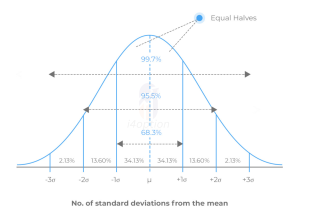The Nifty 50, or Nifty, is among India’s most significant stock market indices.The weighted average of 50 of the biggest and most liquid Indian companies listed on the National Stock Exchange (NSE) makes it a benchmark index. The index is used extensively by investment banks, mutual funds, investors, as well as analysts to analyze the health of the overall Indian economy and the overall market.
Let us explore in depth the background, structure, usefulness, and applications of the Nifty 50 index.
What is the Nifty 50?
The Nifty 50 index is a comprehensive list of 50 leading businesses from 13 different areas of the Indian economy. They are industry leaders and are selected based on rigorous selection parameters, including market capitalization, liquidity, and trading volume. Nifty is provided by NSE Indices Limited, which is a wholly owned subsidiary of the National Stock Exchange of India (NSE). The index is computed based on the free-float market capitalization method. According to this method, only those shares that are available for sale are taken into account while computing the index value.
Key Facts about the Nifty 50:
- Launched: April 1996
- Base Year: 1995
- Base Value: 1000
- Exchange: National Stock Exchange (NSE)
- Calculation Method: Free-float market capitalization weighted
- Update Frequency: Real-time, every 1 second during market hours
Eligibility Criteria for Nifty 50 Inclusion
A firm should fulfill specific requirements to be considered for the Nifty 50:
- Liquidity: Over the preceding six months, the security’s impact cost should have averaged at 0.50 percent or less.
- Listing History: The business should have at least six months of listing history.
- Free-float Market Cap: The stock should be one of the top 100 based on full market
- capitalization and also one of the most liquid.
- Sector Representation: The index seeks to provide diversified sector representation.
The Nifty 50 is adequately diversified across many Indian economic sectors.
Top Companies in the Nifty 50 (as of recent listings)
Here are some of the leading companies in the Nifty 50 index:
- Reliance Industries Ltd.
- HDFC Bank
- Infosys
- ICICI Bank
- Tata Consultancy Services (TCS)
- Hindustan Unilever
- Kotak Mahindra Bank
- Larsen & Toubro (L&T)
- Bharti Airtel
- State Bank of India (SBI)
The list is reviewed and updated semi-annually based on performance and eligibility criteria.
Nifty 50 Significance
1. Benchmark for Indian Equity Markets
Nifty 50 is one of the finest indicators of the health of the Indian stock market in general. When Nifty increases or decreases, it indicates investor mood and perceptions regarding the economy.
2. Passive Investment Tool
The majority of exchange-traded funds (ETFs) and mutual funds replicate the Nifty 50 performance. They are index funds, and they represent an inexpensive means by which investors can be included in a diversified portfolio.
3. Application of Derivatives Trading
Nifty 50 serves as the underlying security for derivatives across a broad spectrum, including options and futures. They are widely traded and support hedging, arbitrage, and even speculative plans.
4. International Recognition
Nifty 50 is followed by foreign investors and also frequently referred to by portfolios based in India. It shows India’s corporate world and financial condition.
How Investors Utilize the Nifty 50
1. Relative Performance Comparison
Investors utilize the Nifty 50 to compare the relative performance of their mutual funds or own portfolios. If a fund consistently performs better than or worse than the index, then the management must have done something wrong.
2. Market Sentiment
Markets observe Nifty 50 trends, technical trends, and volumes to know short-term market sentiment and decide on their trade.
3. Investment Options
Investors seeking exposure to large-cap, stable, and established companies tend to invest in Nifty 50 index funds or ETFs.
Historical Performance of the Nifty 50
Ever since its launch, the Nifty 50 has provided solid long-term returns, an outcome of Indian economy and corporate development. The index has navigated various global financial crises, such as the dot-com bubble, the 2008 financial crisis, the COVID-19 crisis, and spells of high inflation or policy turmoil.
Despite short-term volatility, long-term Nifty 50 investors have largely experienced wealth creation.
Nifty 50-Based Investment Products
- Nifty ETFs: These attempt to mimic the performance of the Nifty 50 index and are listed on the stock exchange.
- Nifty Index Funds:mutual funds that track the returns and investments of the Nifty.
- Nifty Futures & Options: Hedgers and speculators favorite.
Weaknesses of the Nifty 50
The Nifty 50 is a good benchmark but it has its own weaknesses. Some of them are:
- Concentration Risk: It is weighted by some industries (e.g., IT and banking).
- Large-Cap Bias: It does not mirror mid-cap or small-cap performance.
- Lag in Capturing Emerging Trends: Companies that expand quickly might not be captured until they are substantial in size already.
Conclusion
The foundation of the Indian capital markets is the Nifty 50. It symbolizes the strength, breadth, and dynamism of India’s blue-chip stocks and is a useful investment and analytical tool for investors and analysts. Whether you are an active trader, long-term investor, or student of India’s economic destiny, it’s worth learning about the Nifty 50. As India keeps expanding as one of the world’s largest economies, the Nifty 50 will remain an important indicator of market performance and a valuable vehicle for generating wealth.





